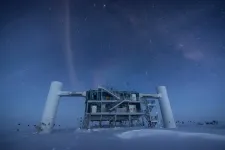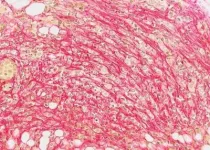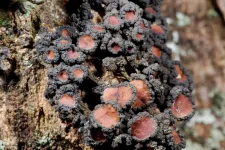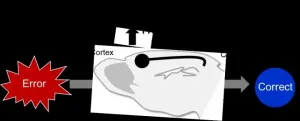Scientists claim that all high-energy cosmic neutrinos are born by quasars
2021-02-22
(Press-News.org) Scientists of the P. N. Lebedev Physical Institute of the Russian Academy of Sciences (LPI RAS), the Moscow Institute of Physics and Technology (MIPT) and the Institute for Nuclear Research of RAS (INR RAS) studied the arrival directions of astrophysical neutrinos with energies more than a trillion electronvolts (TeV) and came to an unexpected conclusion: all of them are born near black holes in the centers of distant active galaxies powerful radio sources. Previously, only neutrinos with the highest energies were assumed to be obtained in sources of this class.
It is believed that there are massive black holes in the centers of active galaxies in our universe. They are the heart of these objects with a luminosity of hundreds of millions of suns. Active galaxies, they are also "simply" quasars, are clearly visible from the earth with both optical and radio telescopes.
Earlier, Russian scientists Alexander Plavin, Sergey Troitsky and the Kovalevs (father and son, both Yuri) have found a connection between the origin of neutrinos of the highest energies (above 200 trillion electronvolts, that is, TeV) and radio quasars. This was quite surprising, because theoretical papers of the 1990s indicated that astrophysical neutrinos would only be born at energies above 1000 TeV.
Neutrinos are tiny elementary particles with a mass barely above zero, but they can cross the universe without interacting with matter and without any delays on their way. Millions of neutrinos per second pass through every person on earth, completely unnoticed. To register neutrinos, an international collaboration of scientists has built a special ice telescope in Antarctica: the Cherenkov IceCube detector with a volume of 1 cubic kilometer. In Russia, INR RAS and JINR are now completing the construction of the Baikal GVD water telescope in Lake Baikal, the volume of which has already reached 0.4 cubic kilometers. Now data acquisition is underway on the running part of the facility, which had already been put into operation. These installations study the sky in different hemispheres: North and South.
After analyzing data collected over 7 years on the IceCube telescope, the scientists initially chose to analyze a range above 200 TeV to study which direction these neutrinos came from. It turned out that a significant part of them was born in quasars, identified by radio telescopes by their high brightness. More precisely, neutrinos were born somewhere in the centers of quasars. There are massive black holes feeding their accretion disks, as well as ultra-fast ejections of very hot gas. Moreover, there is a connection between the powerful bursts of radio emission in these quasars and the registration of neutrinos by the Ice Cube telescope. Since neutrinos travel through the universe at the speed of light, flares come to us at the same time as neutrinos.
Now in their new article published in The Astrophysical Journal, Russian scientists argue that neutrinos of energies in the tens of TeV are also emitted by quasars. As a result, it turns out that all -- well, almost all -- high-energy astrophysical neutrinos are born in quasars. Note, in addition to them, there are neutrinos that are born in the earth's atmosphere, and even in the Ice Cube detector itself during the interaction of cosmic rays with matter.
"It is amazing, since for the production of neutrinos with energies that differ by a factor of 100-1000 different physical conditions are required. The mechanisms of neutrino production in active galactic nuclei discussed earlier worked only at high energies. We have proposed a new mechanism for neutrino production in quasars, which explains the results obtained. While this is an approximate model, it is necessary to work on it, to carry out computer simulation", -- says the chief researcher of INR RAS, corresponding member of the Russian Academy of Sciences Sergey Troitsky. The co-author of the discovery from LPI and MIPT, corresponding member of the Russian Academy of Sciences, Yuri Kovalev, explained the results in the program Hamburg Account on OTR.
In September 2020, a consortium led by the Institute for Nuclear Research of the Russian Academy of Sciences has won a three-year grant from the Ministry of Education and Science with funding of 100 million rubles per year on the topic "Neutrino and Astrophysics of Particles." Seven organizations united together: INR RAS, JINR, LPI, MIPT, SAO RAS, SAI MSU, Irkutsk State University. About 100 scientists will work on solving the problem of the origin of neutrinos, as well as studying their properties. The project also includes other studies aimed at understanding the nature of high-energy astrophysical neutrinos, including the search for photons of the same energy range at the Carpet-3 installation of the Baksan Neutrino Observatory, INR RAS (North Caucasus).
The connection between neutrinos and radio quasars has aroused great interest in the world. The joint work of Russian scientists with the ANTARES neutrino experiment in the Mediterranean Sea begins. A recent article by European and American scientists independently confirmed the discovery of the Russian team using radio telescope data in the United States and Finland. New events of the arrival of astrophysical neutrinos are now tracked by the world's largest radio telescopes and antenna arrays.
In 2021, Russian scientists will collect the first data from the Baikal GVD telescope and analyze it together with the data from RATAN-600 and the world's radio telescope networks, which will allow them to examine the centers of quasars in detail. A lot of interesting things await us.
INFORMATION:
[Attachments] See images for this press release:

ELSE PRESS RELEASES FROM THIS DATE:
2021-02-22
Invasive lobular carcinoma (ILC) is a type of breast cancer that begins in the milk-producing glands (lobules) of the breast. It covers 10-15% of all breast cancer cases, has a high risk of late recurrence, unique metastatic sites, high sensitivity to hormones, unpredictable responses to therapies, unique histopathology, distinctive biology, and resists chemotherapy. More than 90% of ILC tumors also contain estrogen receptors, meaning that they can receive hormone signals from the body e.g. estradiol, that can spur their growth and metastasis.
Despite all this, ILC is relatively understudied compared to other breast cancers, and as a result, there have been very few models developed to study it. The reason is ...
2021-02-22
Water is an essential element for all living things. Understanding the dynamics of water in trees is crucial for understanding the consequences of climate change and altered water availability for forest ecosystems. This study, which is a product of a joint research project with Samuli Junttila PhD, and Professor Masato Katoh of Shinshu University's Institute for Mountain Science and others demonstrates a new laser scanning based method that can be used to monitor changes in leaf water content of tree communities.
Lasers can be used to measure and monitor the leaf water content of trees and plants, because the reflection of laser light at the shortwave infrared region is changed due to varying leaf water ...
2021-02-22
Two in five of the world's plant species are at risk of extinction. In the face of climate change, understanding why certain plant species are vulnerable to extinction while others prevail is more urgent than ever before. Previous studies linking climate and plant vital rates have found relatively modest effects, sometimes leading to the conclusion that other threats, such as land use change, may still be more important than climate drivers. However, these conclusions could result from wrong assumptions about which times of the year (which "time window") climate ...
2021-02-22
- A silicone membrane for wearable devices is more comfortable and breathable thanks to better-sized pores made with the help of citric acid crystals. -
A new preparation technique fabricates thin, silicone-based patches that rapidly wick water away from the skin. The technique could reduce the redness and itching caused by wearable biosensors that trap sweat beneath them. The technique was developed by bioengineer and professor Young-Ho Cho and his colleagues at KAIST and reported in the journal Scientific Reports last month.
"Wearable bioelectronics are becoming more attractive for the day-to-day monitoring of biological compounds ...
2021-02-22
"The lengthy groundwork is finally complete," says Jouko Rikkinen, Professor of Botany at the University of Helsinki, Finland, giving a sigh of relief.
The research article just published focuses on species diversity in the genus Leptogium, a group of jelly lichens that are common in the mountain forests of East Africa. Thousands of lichen specimens were collected from Kenya and Tanzania in 2009-2017, including nearly 600 Leptogium specimens.
DNA analyses revealed that the dataset on Leptogium included more than 70 different species, of which no more than a dozen or so are previously known. DNA analyses were necessary, as ...
2021-02-22
The course and severity of COVID-19 in individual patients is largely influenced by the interaction between the SARS-CoV-2 coronavirus and the human immune system. Normally, the antiviral immune response of natural killer cells (NK cells) is an important step in combating viral replication in the early phase of the infection. On their surface, these killer cells have special, activating receptors, including the NKG2C receptor, which communicates with an infected cell via one of its specialised surface structures, HLA-E. This interaction results in the destruction of virus-infected cells. However, due to a genetic ...
2021-02-22
Professor Jeremy Michalek and his Ph.D student Matthew Bruchon have published a study investigating what vehicle electrification would look like in a world where ridesourcing companies like Uber and Lyft were held responsible for the air pollution and carbon emissions created by their business.
Ridesourcing has changed the way people travel, affecting air emissions in the process. Researchers like those at the Center for Air, Climate and Energy Solutions (CACES) have quantified the negative health effects of airborne particulates created by cars in rates of cardiovascular and respiratory disease, and they're also the largest source of greenhouse gasses in the US. With public sector fleets such as the US Postal Service ...
2021-02-22
Mount Sinai researchers have identified a neural pathway through which the brain detects errors and guides subsequent behavioral improvement. This process, called cognitive control, is frequently dysregulated in a wide range of psychiatric disorders. The team's research, published February 19 in Neuron, also suggests that neurostimulation of this brain pathway could provide an important mechanism for attention adjustments following behavioral errors.
When errors are committed, such as missing a stop sign or running a red light while driving, it's important for our survival to immediately adapt behavior by paying more attention to prevent further errors. This ability to adapt behavior after erroneous actions is one of the key components of human cognitive control.
"Deficits ...
2021-02-22
CORVALLIS, Ore. - Converting the ground under electrical transmission towers into spaces for wildlife can enable fragmented populations to connect with one another, increasing local biodiversity and providing animals around the globe an important tool for adapting to climate change, a new study found.
"The most common way species respond to climate change is to try to shift their range - i.e., go live somewhere else," Oregon State University scientist Virginia Morandini said. "When landscapes become fragmented, usually because of human activity, it greatly hinders animals' ability to move their range. That's why it's so important for biodiversity conservation to try to get their environments connected."
For this study, Morandini ...
2021-02-22
The latest star data from the Gaia space observatory has for the first time allowed astronomers to generate a massive 3D atlas of widely separated binary stars within about 3,000 light years of Earth -- 1.3 million of them.
The one-of-a-kind atlas, created by Kareem El-Badry, an astrophysics Ph.D. student from the University of California, Berkeley, should be a boon for those who study binary stars -- which make up at least half of all sunlike stars -- and white dwarfs, exoplanets and stellar evolution, in general. Before Gaia, the last compilation of nearby binary stars, assembled using data from the now-defunct Hipparcos satellite, included about 200 ...
LAST 30 PRESS RELEASES:
[Press-News.org] Scientists claim that all high-energy cosmic neutrinos are born by quasars





